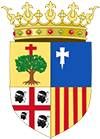Spain's Kingdom of Aragon
Aragon was a medieval kingdom of Spain, one of the prime movers in the Reconquista, and one of the two entities that constituted the beginning of a united Spain. 
What became Aragon, at the foothills of the Pyrenees, was under the sway of Carolingian France and then the Kingdom of Pamplona, which became the Kingdom of Navarre. King Sancho III of Navarre died in 1035; his dying wish was to divide his lands between his three sons, and so to his son Ramiro went Aragon. At that time, the capital was Jaca. As Aragonese forces captured more and more territory from the Moors, the leaders of Aragon 
The consolidation continued, for in 1179 Aragon and Castile agreed to divide between them any lands retaken from the Moors. This included, in 1238, the prize of Valencia, which paved the way for expansion in the Mediterranean arena. One of the first such extensions was into Sicily, which Peter III of Aragon ruled for a time in the late 13th Century. The following century brought Aragonese influence over another island, Sardinia, and, in 1442, the big prize of the Kingdom of Naples. Aragon's influence over its neighbors extended to Navarre, which bowed in deference to Alfonso V in 1425. Later that century, Ferdinand of Aragon married Isabella of Castile. In 1479, they ruled jointly as King and Queen of Aragon and Castile.
|
|
Social Studies for Kids
copyright 2002–2026
David White




